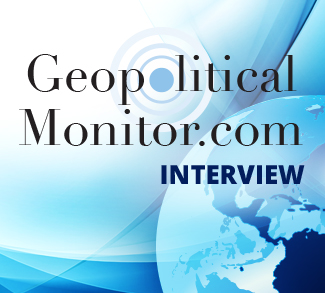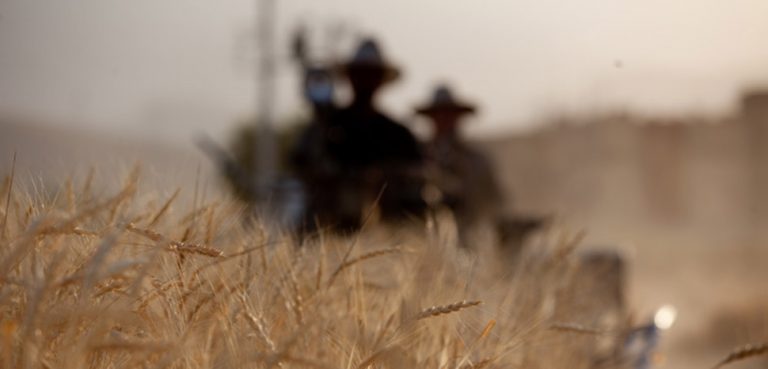In this exclusive interview with the Geopoliticalmonitor, FLOW Program Manager Nancy Goucher provides an overview of the pressing water issues facing Canada and the wider world, such as aquifer depletion, farming pressures, mass migration, and climate change.
The Forum for Leadership on Water (FLOW) is a project of Tides Canada Initiatives that consists of a team of independent Canadian water policy experts, who believe that the best way to effectively tackle current and emerging threats to water security is through a Canada-wide water strategy that incorporates all levels of government and civil society. To this end, FLOW endeavors to identify and close critical gaps in water protection by advancing progressive water governance and policy solutions.
For those of us who are unfamiliar with the problem, could you briefly describe the scope and severity of the global water crisis?
The global water crisis is a real and immediate threat to all of us, and improving the way we manage our water supplies will only become more daunting over time given the combined pressures of rapid population growth, increasing demand, and the uncertainty inherent to climate change.
Currently, there are over 780 million people worldwide without access to safe drinking water and another 2.5 billion without sanitation. Combined, these deprivations account for roughly 3.4 million deaths each year.
The global water picture will almost surely get worse before it gets better. In less than 10 years, half of the world’s population will be living in conditions of water scarcity. By 2030, global demand is projected to outstrip sustainable water supplies by 40%.
Part of this is due to increasing demand for limited resources. By 2030, we will need enough water to support an additional billion people, and the burning question is: where will this water come from? Global fresh water supplies that are readily available are already in decline and most governance structures are unable to adequately manage long-term supply. Of particular concern is the fact that global groundwater levels are falling at drastic rates. Groundwater accounts for nearly half of the drinking water in the world, and it is used to grow food that millions of people rely on. But out of sight means out of mind, and there is little data on how much water actually exists in these underground lakes. As a result, most of them are not managed sustainably or equitably.
Water quality is also an important issue because it can influence clean water supplies and affect the health of our ecosystems. Up to 95% of water in developing countries is polluted to some degree, but the problem also extends to richer countries. One in three U.S. lakes are unfit for swimming, largely due to runoff pollutants and septic discharge.
On top of this, climate change will impose additional pressures in many regions. An average increase in global temperature will generally reduce the size of glaciers and snowpacks, alter the timing of streamflows, and increase instances of both flash and regional flooding. Droughts will occur more frequently, last longer and extend further than before and there will be an increase in extreme weather events such as hurricanes, tornados, and heat waves. Increasingly, water will not be where we want it, when we want it.
What are some of the potential consequences of widespread water scarcity?
Most of us tend to think about water in terms of our daily interactions with it – pouring a glass of water, taking a shower, watering our gardens – but once you think about it a little bit more, you begin to realize how central water is in pretty much every aspect of our lives. Water scarcity will affect everything from global food supplies, to energy prices to the availability of certain consumer products.
Agriculture is the largest global consumer of water resources, and it accounts for roughly 70% of all water withdrawals. We need more food not just to feed growing populations, but also because as people get richer in places like China, they begin to substitute their primarily vegetarian diets with more water-intensive foods such as beef. At the same time that farmers will be trying to accommodate this increase in demand, their productive capacity will take a hit from ever-increasing water shortages (from things like more flooding, drought, rising sea levels, etc.). All of this points to a credible threat to global food supplies.
We also need water to produce energy. Nuclear power plants require water for cooling, water powers the turbines in hydroelectric facilities, and it is used to grow biomass fuels, extract oil from tar sands and to recover natural gas via hydraulic fracturing.
Furthermore, the amount of water required to flow through our economies and produce the goods we consume dwarfs the daily drinking water intake of citizens. Everyday items such as your jeans (11,000L), the shirt you wear (2200L) or your car (400,000L) were all produced using water from somewhere.
In the future, growing water scarcity is likely to decrease the availability of certain products while increasing their price.
Moving along the scale, water scarcity could impact the economic health of critical metropolitan hubs, creating spinoff effects at the regional and even international level. For instance, Mexico City’s 15.6 million people rely on the one viable source of water available to them – an underground aquifer. The aquifer levels have been dropping so significantly that the city is actually sinking (up to 8.5 m in some areas). Just imagine the damage that this is causing to buildings, ancient monuments and infrastructure. These are costs that can have a considerable impact on a country’s infrastructure and finances as well as on the products that are manufactured here and shipped around the world.
Are you aware of any particular regions where water shortages threaten to incite inter-state conflict or large-scale humanitarian crises?
Water shortages are likely to be a more significant source of contention than other resources such as oil in the future.
The most water-stressed areas can be found across northern Africa, the Middle East, central and southern Asia, and northern China. These also happen to be heavily populated areas that are experiencing significant population growth.
Agricultural pressures are particularly worrisome in such places. Water pumped out of the ground today fell as rain thousands of years ago. Once this fossil water disappears, there’s little new rainfall to replenish it.
While tensions have historically led towards the development of water-sharing agreements, the added strain in these areas will make such agreements less tenable in the future.
We should also consider the potential for mass migration as people flee areas with water and food shortages, or areas affected by climate-change and rising sea level.
What can be done to fix the problem on the international level, and are there any exemplary efforts currently taking place?
A lot of water supply problems are being aggravated by issues such as climate change and increasing demand for resources. Any worldwide solution would therefore need to include a strategy for reducing greenhouse gas emissions and address exponential population growth.
Reducing overall consumption of products and energy as well as stepping up our efforts to promote water efficiency can also be helpful in reducing both our carbon and water footprints.
When gauging a given problem on a global scale, it is easy to be overwhelmed by the complexity and scale of necessary interventions. However, I am hopeful that the numerous small initiatives happening at the community scale will have far reaching impacts.
In terms of moving forward, sustainable global water management will require:
- Increased collaboration between governments, farmers, businesses, Aboriginal populations, non-governmental organizations and other stakeholders.
- Increased worldwide awareness and knowledge about the problems facing our collective water resources.
- Recognition of the importance of water for nature: a certain amount of clean water is required to keep streams, lakes and ecosystems healthy, and in turn support human life.
- Renewed governance structures and regimes that promote fairness, equity and a collaborative approach to decision-making regarding water.
Where does Canada fit into the global water picture in terms of existing resources and our rate of depletion?
We often hear that Canada has one fifth of the world’s fresh water. In fact, over 80% of Canadians believe that we have more water than any other country in the world. This is not true. We are actually tied for third place with the United States behind Brazil and Russia for renewable fresh water supplies. If you look at how much water we can use without depleting resources (the “renewable rate of supply”) as well as the amount which is actually accessible, Canada has about 2.6% of the global water supply.
The “myth of abundance” of Canadian water has created a lot of problems: Canadians are the largest consumers of water in the world, other than the US; our pollution policies are among the weakest in the industrialized world; and much of our data and maps are severely out of date. We seem averse to investing the resources needed to manage water in a sustainable way at least partially because we believe we have a limitless supply.
While most Canadians think everything is fine, there are troubling signs for the future.
Nationwide between 2005 and 2007, six in ten water monitoring sites rated no better than “fair” in quality. The water at nearly a fifth of the sites was either “marginal” (14 percent) or “poor” 4 percent. On the whole, water availability in the most populated areas of Canada is also decreasing – the amount of renewable water available has dropped the equivalent of 3.5 cubic kilometres (or 8.5%) per year from 1971 to 2004.
What are some of the good things that Canada is currently doing with regards to protecting water supplies?
There is a lot of positive work being done by our provinces and territories. The Government of the Northwest Territories, for example, is implementing a new water stewardship strategy that contains some very innovative and ambitious water management principles. It strives to ensure all waters remain “substantially unaltered in quality, quantity, and rates of flow.” They undertook an incredibly collaborative and inclusive process to develop the strategy, which they hope translates into co-implementation. The decision-making process will respect all ways of knowledge, including traditional or aboriginal knowledge, and principles such as adaptive management and the precautionary principle are embedded into the strategy. While much remains to be done, there is a strong policy foundation there from which to work now.
And some of the bad things?
There has recently been a lot of concern over the federal government’s declining interest in water resource management.
Many federal water programs have been drastically downsized or disbanded since the peak of federal water interest in the 1970s and 1980s. And while Environment Canada and other associated departments have experienced major cuts over the years, the last two federal budgets have been particularly hard on water science and policy. Thousands of public sector employees working on water issues have been cut or reassigned. Important national institutions and programs have been abolished, including the National Roundtable on the Environment and Economy, the Municipal Water and Wastewater Survey and the Environmental Lakes Area program. Habitat protection provisions in the Fisheries Act – which made it one of Canada’s strongest pieces of environmental legislation – have been removed. Protection under the Navigable Waters Protection Act is now limited to only 62 rivers and 97 lakes.
Unfortunately these changes are happening at a time when Canada should be strengthening its protection of water. With so many countries facing an uncertain future regarding water, Canada could use this opportunity to stand out as a responsible steward of a globally significant resource.
What’s at stake in the Canadian context? Give us a potential worst-case-scenario for 25 years from now.
The recent decisions at the federal level have further undermined government capacity to anticipate and respond to the very real threats to Canada’s water resources.
Canada’s rivers, lakes and groundwater systems are already under a lot of stress in the face of competing demands for water supply, population growth and climate change.
Lake Winnipeg is among the most ecologically-compromised of the world’s great fresh water lakes. Massive algae blooms, covering up to 15,000 km2, choke fish and threaten aquatic biodiversity. The challenges are tough and multifold – there are pollutants running off from the surrounding farm fields, invasive species from the U.S. and political wrangling from leaders in the basin’s four U.S. States and four provinces.
The Great Lakes are also an important example. While we noticed improvement in the lakes after the signing of the Great Lakes Water Quality Agreement in 1972, the situation has progressively gotten worse over the last couple of decades.
Since the 1970s, there has been a 50-80% reduction in ice on the Great Lakes, which increases evaporation and surface water temperature. More extreme precipitation events wash pollutants into the lakes. More pollution along with higher temperatures are likely to result in more water-borne organisms, more toxic algal blooms, and problems with our drinking water. The combined effect is a decline in both lake levels and water quality. This speaks to the importance of continuously investing and studying our water bodies because we need to find ways of responding to new and emerging threats.
Climate change is also having an impact on Canadian water sources. As many as 300 glaciers in the Canadian Rockies have disappeared between 1920 and 2005. If the warming trend continues and shrinks the mountain snowpack beyond sustainable levels, there will be water supply challenges for the hundreds of thousands of Canadians who rely on the rivers that are fed by those mountain sources.
In terms of policy, what is the one law that the Canadian government could pass that would go farthest in protecting Canada’s water supply?
FLOW believes that Canada needs a national water strategy. It would need to be about the health of our lakes and rivers but also address the water needs of communities, industry, energy, agriculture and aquatic ecosystems through collaboration with all levels of government, First Nations, industry, non-government organizations and other stakeholders.
We do not have to start from scratch – we can learn from examples such as those in the Northwest Territories, and internationally like what the European Union achieved with the Water Framework Directive, which has increased water collaboration and protection across the continent.
In Canada, such a strategy needs the involvement of the federal government. Important issues such as transboundary agreements, water exports, air pollution, and a nationwide reduction of greenhouse gases cannot be adequately addressed without federal intervention.
But more than any other issue in Canada, water has the power to unite Canadians and transcend differences in political philosophy, ethnicity, and geographical location. So I am hopeful that there is space and desire to move forward to protect Canada’s most valuable resource.
For more information on the water issues mentioned in this interview, please visit FLOW Canada.




